



Sixth in a series
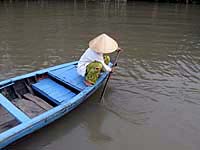
Matt and I join a trip from Saigon to the Mekong Delta, hoping to see the beauty in what was once one of the Delta's hottest war zones. We're heading for Ben Tre province, some 45 miles southwest of Saigon.
The Mekong Delta reminds you that most of Vietnam's people still make a living from working the land.
The Delta is the richest region in Vietnam, providing 50 percent of the country's rice and 60 percent of its fish, a main source of protein. Its 17 million people in nine provinces went through tough times for more than a decade after the communists took power in 1975.
The communists banned private ownership and tried to collectivize the economy. The result was food shortages and near famine. Normally rice-rich Vietnam became an importer of rice.
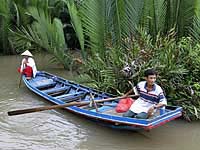
Our host on this trip is an old friend who worked as an American aid worker in the Delta in the early 1960s, then covered the war as a journalist until the fall of Saigon, and now runs regular tours to Vietnam. Guiding off the beaten track has always been his first love.
I haven't been in the Delta in more than 30 years, and the changes I see are enormous. Our guide points out that the region's farmers have moved away from growing mostly rice and coconuts. We see fruit orchards everywhere along the banks of the river.
Among the crops are lychees, mangoes, jackfruit, durian, longans, and rose apples.
Entire islands that once were barely marginal have been turned into fruit farms.
Bustling My Tho, 40 miles southwest of Saigon, is now a port for a colorful fleet of fishing boats venturing into the South China Sea. Ice factories lining the shore supply them for their next trip out.
Just opposite My Tho, fish farmers in floating houses raise thousands of fish in large cages just beneath their living rooms.
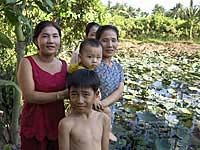
This part of the Delta with its orchards, lotus ponds, and emerald-green rice paddies looks like a piece of paradise. But I know from my reading that the Delta as a whole has problems that include annual floods, salt water intrusion, the overuse of pesticides that damage health and the environment, and the pressures of a growing population.
Too many people live on too little land.
By the late 1990s, according to one study, nearly one out of five farmers in the Delta had become a low-wage landless laborer.
Reminders of the Vietnam war intrude from time to time. We visit a hamlet, Ap Bac, where well-organized Viet Cong guerrillas first showed in 1963 that they could defeat a sizable force of U.S.-backed South Vietnamese troops.
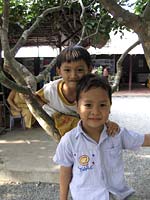
We travel in a minibus with several colleagues, including Tim Page, a photographer who was wounded four times during the war. Page recounts the time he was strafed by an American fighter-bomber when it accidentally attacked a U.S. Navy ship.
Finally, after a stop at a family-owned coconut candy business, we have a brief chance to explore the creeks and canals that crisscross Ben Tre Province. We glide in blue-painted boats with water-palm fronds on either side of a canal arching above us.
Then on to the village o333f Phu Tuc, where we spend the night at a family guest house.
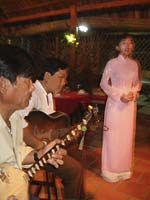
We listen to southern Vietnamese opera music provided by a fine female singer backed by two energetic stringed-instrument players. I can understand only a few words, but their music is moving.
I'm sure that when we wake up in the village, I'll look for signs of the war again. But for now, as I fall asleep in a place of honor near to a decades-old altar to a family patriarch, the war begins to fade from my mind.
Produced for the Web by Maggy Sterner